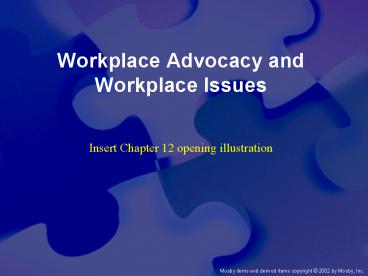Workplace Advocacy and Workplace Issues PowerPoint PPT Presentation
1 / 26
Title: Workplace Advocacy and Workplace Issues
1
Workplace Advocacy and Workplace Issues
- Insert Chapter 12 opening illustration
2
Key Concepts
- Workplace advocacy to improve the quality of
health care - Issues affecting professional nursing practice
- Resources to assist in improving the workplace
- Advocating for safe and effective workplace
environments - Internal and external workplace strategies for
quality patient care
3
Overview
- Nurses are struggling to deliver patient care
against many barriers - Commitment to quality care and advocacy may place
nurse in direct conflict with administrators
4
Professional Practice Advocacy
- Umbrella of activities to promote a professional
practice environment - Workplace advocacy
- Collective bargaining
- Activities supportive of
- Patient advocacy
- Professional practice self-determination
- Employment rights and responsibilities
5
Professional Practice Advocacy Examples
- Promoting occupational safety and health
- Using political processes to influence and
protect nurses and patients rights - Developing public reactions and conflict
resolution skills - Building coalitions and support groups
6
Workplace Advocacy
- Activities initiated to address workplace
challenges - Safe and effective workplaces are promoted by
knowing where to seek information - American Nurses Associations (ANAs) Commission
on Workplace Advocacy supports workplace advocacy
7
Workplace Advocacy Examples
- Develop conflict resolution models to address
patient care concerns - Identify mechanisms for RNs to affect
institutional policies - Seek legislative solutions for workplace problems
- Develop legal centers for legal support and
decision-making advice
8
Workplace Issues
- Nursing shortage
- Appropriate staffing
- Patient safety
- Workplace safety
9
Nursing Shortage Overview
- Managed care influenced cyclic shortages in the
late 1990s and in early 2000 - Current shortage is more complex and long lasting
- Nursing employment opportunities will grow more
rapidly than all other U.S. occupations through
2008 - Planning for an adequate nursing workforce will
be a critical challenge
10
Nursing Shortage Issues
- Health care is no longer a favored employer
- Decline in nursing school enrollments
- Increasing demands for nurses with specific
education and skills - Faculty shortage
11
Nursing Shortage Issuescontd
- Nurse retention
- Aging workforce
- Foreign nurse recruitment
- Compensation
- Work environment
12
Appropriate Staffing
- Factors contributing to inadequate nurse
staffing - Nursing shortage
- Cost-cutting initiatives related to managed care
- Absence of data to quantify effect of staffing on
safety and quality
13
Mandatory Overtime
- Mandatory overtime/mandatory on-call requirements
have increased - Mandatory overtime studies
- Increased time lost to absenteeism
- Increased injuries
- Required 3 hours of work to produce an additional
2 hours of productivity
14
Mandatory Overtime Issues
- May alleviate the employers sense of urgency to
proactively find more appropriate staffing - Nurses may feel resentment to bear the personal,
professional, and legal burden for the staffing
problem
15
Floating
- Nurses increasingly required to float to other
patient care units - Floating issues include
- Questions regarding knowledge, expertise, and
experience needed to work in the area - Time for orientation and training
- Availability of support from experienced nurses
16
Chapter Resources
- Questions about safe staffing to ask before
accepting a position (Table 12-3) - Resources to help decision making regarding
adequate staffing and mandatory overtime (Table
12-4) - Questions to help make decisions to accept or not
accept an assignment (Table 12-5)
17
Shared Governance
- Gives nurses an active role in decision making
- Attributes include independence, accountability,
and autonomy over nursing practice - Results in increased job satisfaction and
efficiency and better patient outcomes - Goes beyond participatory management through
creation of structures to govern nursing practice
18
Patient Advocacy and Safety
- Patient advocacy is the cornerstone of nursing
- Complex systems and complicated technology lead
to errors and adverse events - Nursing must assert its powerful voice to promote
safer health care systems
19
Errors in Health Care
- Two major studies indicate that errors in health
care delivery kill 44,000 to 98,000 people in
U.S. hospitals annually - Nursing organizations are attempting to
demonstrate the link between nurse staffing and
patient adverse events
20
Whistleblower Protection
- Protects nurses who speak out about unsafe
situations through appropriate channels - Advocated for at the federal level and has passed
in some states
21
Nursing Quality Indicators
- Major changes in care and staffing are occurring
with few data to justify the effects on safety
and quality - Professional organizations are working to collect
and publicize data to link nurse staffing mix
with patient outcomes
22
ANAs Nursing-Sensitive Indicators
- Mix of RNs, licensed practical nurses (LPNs), and
unlicensed staff caring for patients - Total nursing care hours provided per patient day
- Pressure ulcers
- Patient falls
- Patient satisfaction with pain management
23
ANAs Nursing-Sensitive Indicatorscontd
- Patient satisfaction with educational information
- Patient satisfaction with overall care
- Patient satisfaction with nursing care
- Nosocomial infection rate
- Nurse staff satisfaction
24
Workplace Safety
- Needlesticks
- U.S. health care workers experience 800,000
needlesticks annually - Legislation is being passed to protect workers
- Ergonomic injuries
- Back injuries affect 38 of all nurses
- Workplace violence
- Major societal issue
25
Advocating to Prevent Workplace Violence
- Organizational assessments to identify high-risk
environments, psychological conditions, and
populations that threaten safety - Staff education to address the identification and
response to high-risk behaviors that can lead to
violence
26
ANA's Workplace Advocacy Program
- Advocates for administrative controls
- Adequate staffing
- Health and safety committees
- Engineering controls such as ventilation and
safer needle-stick devices - Personal protective equipment such as respirators
and synthetic gloves

